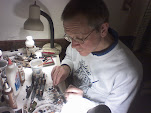The origins of my French Revolution project are now lost in obscurity. I originally bought a set of the 40mm Nuernberger Meisterzinn molds for the purpose of adding some expansion units to Chris Palmer's French and Indian War project. I started thinking about what else I could do with them, and realized that the different heads included covered a number of French Revolution types, and somehow the idea that a Scarlet Pimpernel-based scenario would give me another use for the molds as well as provide an excuse to put a marching band on the table in a game pushed this over the edge, from thinking to doing. That also tied the time down to 1793-4.
My main resources for painting were the Funcken Uniforms of the French Revolution book, and the Haythornthwaite book on the same topic.
In the initial scenario development (and I have the notes around here somewhere...) the idea was that each player would have one unit, each of which would have its own separate victory conditions. We also had a suggested set of variant victory conditions, so that we could run the game multiple times and playing previously would not be a spoiler, because the hidden information could be different each time. What stayed the same is that the Austrians were more-or-less working together to take a military objective (a bridge), and the French national guardsmen (or Les Bleus) were tasked with defense of the objective, and a special order to capture the Scarlet Pimpernel. One of the other five French factions (regulars, cavalry, mounted police, band, and civilians) would not be what they seemed, but would be the Pimpernel, his assistants and some French nobles attempting to escape.
Each mounted faction was built with eight figures, and each foot faction was built with twelve. We ended up with a few extra civilians as well. As always, Ross Macfarlane decided to pitch in and help with the painting (and more, as will be shown).
Ultimately, we played this a few times in 2007-8, and it got shelved with a mental note that the rules I was using needed some work, and that not all of the factions were fun to play. It was close, but not quite there.
When I got A Gentleman's War (AGW) last month, I realized that it might be just what I was looking for to get the French Revolution back on the table, although as a small battle game rather than a skirmish. The presence of an extended section on "cameo roles" gives something to do with civilians, bandsmen, and the Pimpernel. I discussed the idea with Ross, who was very enthusiastic, and recommended a couple of sources on the 1793/4 campaigns in Flanders.
Part 2 will be more about where this might be going, but here's a quick review of what there is:
First up are the Paris mounted police. I have a feeling that finding a battlefield role for these guys may be difficult, but perhaps we can just slide them in as a French cavalry unit without drawing any particular attention to them. I'll mention here that the mold collection has two horses, but I have only been able to regularly cast the horse that comes with cuirassier body successfully. All of the mounted police were built using the "hussar" body, with the cast-on lapel lace filed off.
 |
| Paris mounted police, from Funcken |
 |
| Close-up of one mounted policeman |
 |
| Austrian Cuirassier, from Haythornthwaite |
 |
| French Chasseur a Cheval, from Funcken |
 |
| French Marching Band |
 |
| French Garde National |
 |
| Old French regular army |
 |
| Austrian infantry |
Early on, the civilians stalled me. Chris Palmer tried a couple of civilian conversions for me, the fellow in the green coat with a spike club, from a Meisterzinn SYW officer, and the guy with the pitchfork, from a Meisterzinn 16th century halberdier. Ross, in a burst of enthusiasm, decided to sculpt a couple of civilians and make molds, so the rest of the men are from one of those two masters with varying amounts of conversion. The women are straight out of the Meisterzinn civilian mold, with both possible heads included.
 |
| Civilians, some rather militant |
I did one of the male civilians from the Meisterzinn mold up as a Representative on Mission, as a wild card for the Scarlet Pimpernel scenario. He comes with the roll of paper clutched in his left hand, here undoubtedly representing a blank death warrant.
 |
| A Representative on Mission |

In my mind there were considerably more units than that! Oh well, there will be!
ReplyDeleteProbably the eight player set-up made it feel like more...or you're imagining the expansions we've discussed previously. :D
Delete